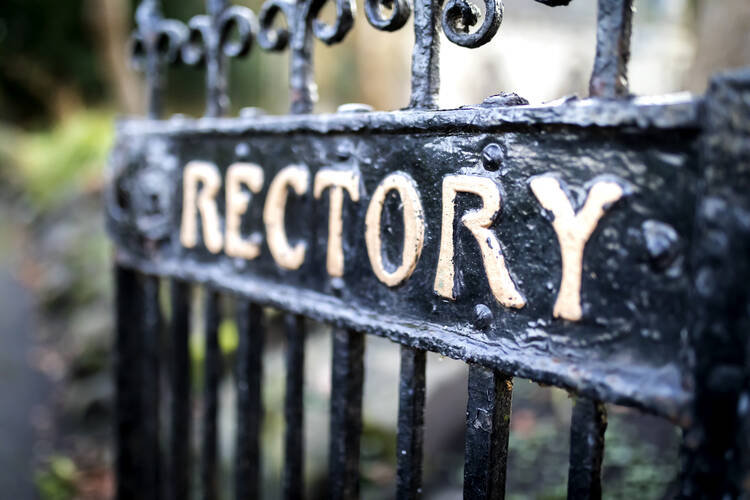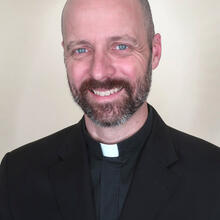Green shag carpeting and wood paneling. Empty and dusty. Remodeled and vibrant.
Have you been inside your parish rectory?
In my ministry as a Jesuit, I often travel to diocesan parishes to lead retreats and workshops. I have stayed in parish rectories that are bright, clean and welcoming. I’ve stayed in zombie rectories where no priest has lived for 10 years. These are a mishmash of storage space, offices and awkward housing for visitors. I’ve stayed in rectories that are completely empty. I mean it: a bed, a box of baking soda in the fridge and that’s it. This pastor led several parishes; he lives in one rectory and invited me to stay in another—empty—rectory. I asked the pastor, “After I finish the talk tonight, what should I do for dinner?” He shrugged. “Maybe the gas station will still be open then?” It wasn’t. His diet seemed to consist of Coke Zero, Cheerios and frozen pizza.
For over 100 years, the rectory has been a living symbol of Catholic Americana. Where does the priest live? Right there, next door to the church. Some rectories remain vibrant centers of faith and community. Some are being reimagined in Christ-centered ways. A few need a wrecking ball. Many of these brick and stone structures were built in the 1940s or 1950s. They were designed to house four to eight priests. Most now house one priest—or sometimes none, if one pastor serves multiple parishes.
For over 100 years, the rectory has been a living symbol of Catholic Americana. Where does the priest live? Right there, next door to the church.
A recent study of Catholic priests in the United States titled, “Well-being, Trust, and Policy in a Time of Crisis,” indicated that 77 percent of priests are “flourishing,” according to their score on the Harvard University flourishing index. But many priests—even those who are flourishing—also reported indicators of burnout, especially among younger priests. Sixty percent of priests under the age of 45 reported signs of burnout, with nearly one in 10 of these young priests reporting “severe burnout.” The reasons they named are familiar to anyone working in church ministry: the sexual abuse crisis, parish mergers, as well as friction between priests and bishops.
These data make clear what many Catholics already know: Priests need supportive structures and relationships so that they can live wholesome and holy lives in our challenging and changing American context. My visits to rectories have helped me conduct an informal study of the joys and challenges that come with how priests are living today. It has made me wonder: How can we reimagine and repurpose rectories to meet the current needs of priests and parishes? Based on the survey results and my own experience, having a young priest live alone in a large rectory is not a recipe for priestly “flourishing.”
My high school classmate, the Rev. Scott Wallisch, is the pastor of St. Joseph Catholic Church, a large suburban parish in Kansas City, Kan. He has lived in a rectory with three other priests for most of 2023. Two young priests serve as chaplains at Catholic high schools, and an older priest assists at the parish. With four priests in the house, it has “forced us to be more intentional,” he said. They try to pray together and share dinner one or two nights each week. Because of their schedules, he admits, “It’s hit or miss so far.” He has also hosted seminarians who work at a parish as part of their formation. Again, Scott says, “When we have a seminarian, I’m more intentional” about scheduling meals and prayers.
Priests need supportive structures and relationships so that they can live wholesome and holy lives in our challenging and changing American context.
Scott is also in a faith-sharing group that belongs to the Jesus Caritas Fraternity of priests in the United States. He meets with several area priests each month for prayer, a meal and conversation about life and ministry. His group has been meeting regularly for years. Similar faith-sharing groups for priests are popular in Kansas City, Minneapolis, Denver and in other dioceses.
I wondered: Could these priests live together? Each would then need to drive from their common residence to his parish. What if one was reassigned to a parish 60 minutes away? Some bishops encourage (or require) their seminarians and young priests to join these groups as a structure of fraternity and support.
Another Catholic structure could help prevent isolation: the deanery. Large dioceses are divided into deaneries. These are administrative subdivisions within a diocese that may encompass a few towns or counties. St. Louis has six deaneries. Could a bishop arrange for the priests in a Jesus Caritas group to serve in the same deanery while living together in one rectory?
Scott is also the former vocation director for his diocese; that means that he stayed in many rectories while leading events to promote vocations. He has seen other challenges there. Some priests live alone in isolated rural towns, serving several parishes. “A lot of guys seem happy being on their own, being out in the country, having their own place. But, as brothers, we need support. That probably means having at least one other guy in the rectory,” he said.
Maybe living above the office is no longer a good arrangement. If the priest is always available and findable, then when does he get a break?
Other priests work in busy churches in cities and suburbs, and this sometimes means sharing their home; they live above the offices for parish staff. I lived in a rectory like this in Belize, after my ordination, with the pastor and an associate. The pastor was in his 80s; he typically had Mass and sick calls in the morning, and then meetings in the evenings for things like marriage prep and the parish council. The afternoons were his “down time” for reading, resting and a nap. The parish secretary would sometimes knock on his bedroom door in the middle of the day: “Father, someone wants to talk with you.” Perhaps he should have set clearer boundaries. Or maybe living above the office is no longer a good arrangement. If the priest is always available and findable, then when does he get a break?
During this past Lent, I preached at a newly established parish in Atlanta, Mary Our Queen. It has no rectory. The pastor, the Rev. Charles Byrd, lives in a condo nearby. His housing is modest but tasteful with religious art and a full kitchen. He has an inviting guest room that is used for visitors (including me), with thoughtful decor of historic Georgia: black and white photos, colorful postcards and Civil War maps. He currently has a seminarian staying with him for a parish ministry experience. He invites his staff over for meetings periodically. He also asks engaged couples to come for a meal as part of their marriage preparation. From the outside, it looks like an ordinary condo. His parish council has asked him if he wants to build a rectory. He’s not sure. A rectory “is a nice symbol, and it’s convenient,” he said. “But what we have now is working.”
I’m a member of the Society of Jesus, a religious order. Our living arrangements are different from those of our diocesan brothers. I live at Marquette University in Milwaukee, Wis., with 30 other Jesuits. Men here serve at our university, two Milwaukee high schools, two parishes and other city ministries. Some are retired. A few are young Jesuit priests from other countries doing graduate studies. It is an eclectic mix of ages and personalities.
My community is not perfect, but these relationships are essential to my life and vocation.
Sometimes at lunch, the members of my Jesuit community share lively discussions about our varied ministries and experiences. At other meals, the older men sit at one table and I join the younger men at another. My community is not perfect. But I do live with Jesuit friends and older mentors; these relationships are essential to my life and vocation. I travel a lot and I’m glad to see them at dinner when I return.
I’m not trying to tell my diocesan brothers, “Do what the Jesuits do.” I am saying that I care about them. We need our parish priests. I want them to be healthy and supported. Where they live and how they live is important and how a diocese or parish approaches decisions about it should be deliberate and carefully thought through. Could several pastors in a deanery live in one rectory—even if this means driving 10 to 15 minutes to their parishes? Should large rectories be used exclusively for parish offices and meeting spaces– and the pastor provided with a modest, comfortable condo? Can his new residence be a home for spiritual and pastoral events?
Thinking intentionally about how we live can sometimes lead us to surprising results. Paul Lickteig, S.J., is a Jesuit friend who serves as pastor at St. Xavier, a Jesuit parish in Cincinnati. All the Jesuits in Cincinnati live in a single, city-wide community. The parish rectory is largely unused. He spoke with his staff and Jesuit community. After prayer and discussion the parish agreed to a bold new initiative: housing a family of refugees from Ukraine. Many details need to be worked out. How long will they stay? Who will help them with transportation, shopping, language skills? Paul noted, “People at the parish are excited. They all read the news and it can all feel so overwhelming—there’s all these problems and we can’t do anything about it. Well, we can do something. And we’re doing it together.”
Rethinking housing for our parish priests is essential in a changing American Catholic landscape. Fruitful discernment can lead to more wholesome living arrangements for our priests; unused and underused rectories can be reimagined for holy new purposes.








